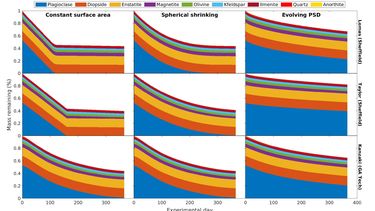Scientific goals
We aim to develop a framework for model parameterization, inputs, outputs or model validation against empirical data.

Off
We aim to
- quantify behaviour of participating models in response to key drivers of weathering and carbon capture
- elucidate major sources of model uncertainties
- develop best practices for benchmarking and validation
- facilitate transparency via open-source, well-documented code when papers published
Participants will be provided with the following input data:
- Precipitation
- Air and soil temperature
- Atmospheric pCO2
- Feedstock data
- Treatment timings and quantities
- Treatment mineralogies with standard kinetic and thermodynamic data
- Secondary phases to be included/reported
- Soil data
- Texture data, cation exchange capacity, organic carbon,
- Soil thickness to be modelled
Participating models will deliver the following time-series outputs:
- Carbon dioxide removal (CDR), i.e. bicarbonate in effluent (analogous to CO2 consumption measured using river chemistry data)
- CDR potential, i.e. release of major cations from applied minerals during weathering
- Individual mineral mass losses (percent)
- Selected secondary phases (e.g. calcite)
- Soil and effluent solution chemistry: pH and major ion concentrations
Each part of the project will answer the following research questions:
- How similar are the results from the participating models?
- Can we explain any major differences between models?
Where observational data are available, we will also quantify:
- Root-mean-square error for each model and each available type of observation
- Multivariate root-mean-square error (R has a package that calculates this as the mean of all the individual RMSEs scaled by their standard deviations)
